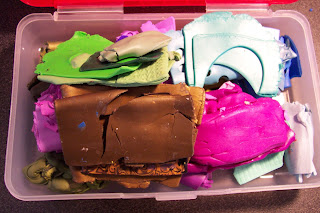One of the things I love about working with polymer clay is there is very little wastage of materials. I'm a pretty frugal person and want to do my part to save the environment so I hate throwing unnecessary things away and try to recycle and reuse any time I can. Every polymer clay artist ends up with scrap clay and the neat thing is that it never gets thrown out! It can always be reused in some way and so I thought I would start a series of ideas on what I do with it. If anyone has other tips to add or links to share, we'd love it if you leave a comment.
While I'm claying, I generally throw my scraps in a container. I like this pencil case as the plastic doesn't react with the clay and it has a lid to help keep any dust or lint out. I don't worry too much about mixing it yet but try to keep the colors separate.
My clay pile was overflowing the other day -- in fact I ended up with 2 boxes full so decided it was time to do something with it. You can just grab any clay and mix them and end up with all sorts of "mud" colors (browns, etc.) but I like to see what new colors I can end up with.
I first like to sort my clay by colors -- greens, pinks/reds, blues, browns/golds, silver/black, yellows, oranges. If I don't have enough of a certain color for a pile then I will either set it aside and save it for later or add it to a pile I think will mix in well and not create a mud.
When I have a pile that is too much to mix I will then separate that pile further. Here I had a lot of pinks so I divided it into light and dark.
I then decided it was still too much, so I divided the pinks into 3 piles and here I now have 3 shades of pink -- one dark and 2 lighter mixes.
I kept mixing my other clay piles the same way and here are all the clay sheets in a variety of colors I ended up with.
Now to store my clay for later use ... You can wrap them in plastic wrap if you wish. I like to separate my sheets with pieces of parchment paper to keep them from sticking together and stack them in a basket that I have handy on my table.
Tomorrow I will share more with you on what I can do with all this clay.

























































